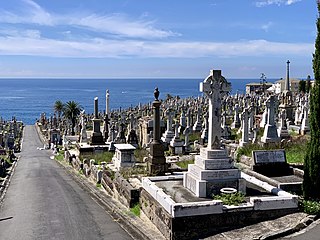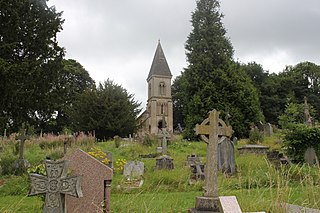
Monumental masonry (also known as memorial masonry) is a kind of stonemasonry focused on the creation, installation and repairs of headstones (also known as gravestones and tombstones) and other memorials. [1]

Monumental masonry (also known as memorial masonry) is a kind of stonemasonry focused on the creation, installation and repairs of headstones (also known as gravestones and tombstones) and other memorials. [1]
In Christian cultures, many families choose to mark the site of a burial of a family member with a gravestone. Typically the gravestone is engraved with information about the deceased person, usually including their name and date of death. Additional information may include date of birth, place of birth and relationships to other people (usually parents, spouses and/or children). Sometimes a verse from the Bible or a short poem is included, generally on a theme relating to love, death, grief, or heaven.
The headstone is typically arranged after the burial. The choice of materials (typically a long-lasting kind of stone, such as marble or granite) and the style and wording of the inscription is negotiated between the monumental mason and the family members. Because of the emotional significance of the headstone to the family members, monumental masons have to be especially sensitive in their dealings with family members, especially in relation to the trade-off between expectations and cost. [1]

Unlike the work of most stonemasons, the work of the monumental mason is of small size, often just a small slab of stone, but generally with a highly detailed finish. Generally gravestones are highly polished with detailed engraving of text and symbols. Some memorials are more elaborate and may involve the sculpture of symbols associated with death, such as angels, hands joined in prayer, and vases of flowers. Some specially-made stones feature artistic lettering by letter cutters.
By the beginning of the twentieth century the craft had deteriorated to the point that Lawrence Weaver felt compelled to write, "To-day many of the persons who are curiously called 'monumental masons' bring to their task neither educated taste nor the knowledge of good historical examples; they are often, moreover, incompetent in their craftmanship. The more important shops which purvey marble monuments are, if anything, rather worse, for they stereotype bad designs, which are the more offensive because more ambitious and costly. The clerical tailors who sell most of the engraved brasses have mainly succeeded in making that form of memorial the most dreary. All three sources of supply have added a new terror to death." [2]



Masonry is the building of structures from individual units, which are often laid in and bound together by mortar; the term masonry can also refer to the units themselves. The common materials of masonry construction are brick, building stone such as marble, granite, and limestone, cast stone, concrete block, glass block, and adobe. Masonry is generally a highly durable form of construction. However, the materials used, the quality of the mortar and workmanship, and the pattern in which the units are assembled can substantially affect the durability of the overall masonry construction. A person who constructs masonry is called a mason or bricklayer. These are both classified as construction trades.

A cemetery, burial ground, gravesite or graveyard is a place where the remains of dead people are buried or otherwise interred. The word cemetery implies that the land is specifically designated as a burial ground and originally applied to the Roman catacombs. The term graveyard is often used interchangeably with cemetery, but a graveyard primarily refers to a burial ground within a churchyard.

Stonemasonry or stonecraft is the creation of buildings, structures, and sculpture using stone as the primary material. It is one of the oldest activities and professions in human history. Many of the long-lasting, ancient shelters, temples, monuments, artifacts, fortifications, roads, bridges, and entire cities were built of stone. Famous works of stonemasonry include the Egyptian pyramids, the Taj Mahal, Cusco's Incan Wall, Easter Island's statues, Angkor Wat, Borobudur, Tihuanaco, Tenochtitlan, Persepolis, the Parthenon, Stonehenge, the Great Wall of China, and Chartres Cathedral.

The Waverley Cemetery is a heritage-listed cemetery on top of the cliffs at Bronte in the eastern suburbs of Sydney, New South Wales, Australia. Opened in 1877 and built by R. Watkins and P. Beddie, the cemetery is noted for its largely intact Victorian and Edwardian monuments. It is regularly cited as being one of the most beautiful cemeteries in the world. The cemetery contains the graves of many significant Australians including the poet Henry Lawson. Also known as General Cemetery Waverley, it was added to the New South Wales State Heritage Register on 28 October 2016.

A headstone, tombstone, or gravestone is a stele or marker, usually stone, that is placed over a grave. It is traditional for burials in the Christian, Jewish, and Muslim religions, among others. In most cases, it has the deceased's name, date of birth, and date of death inscribed on it, along with a personal message, or prayer, but may contain pieces of funerary art, especially details in stone relief. In many parts of Europe, insetting a photograph of the deceased in a frame is very common.

A stele, or occasionally stela, when derived from Latin, is a stone or wooden slab, generally taller than it is wide, erected in the ancient world as a monument. The surface of the stele often has text, ornamentation, or both. These may be inscribed, carved in relief, or painted.

A monumental inscription is an inscription, typically carved in stone, on a grave marker, cenotaph, memorial plaque, church monument or other memorial.

Salem Street Burying Ground is a cemetery located at the intersection of Salem Street and Riverside Avenue in Medford, Massachusetts. The Salem Street Burying Ground was used exclusively from the late 17th century to the late 19th century for the burial of the town's wealthy. The cemetery was listed on the National Register of Historic Places in 1981.

A church monument is an architectural or sculptural memorial to a deceased person or persons, located within a Christian church. It can take various forms ranging from a simple commemorative plaque or mural tablet affixed to a wall, to a large and elaborate structure, on the ground or as a mural monument, which may include an effigy of the deceased person and other figures of familial, heraldic or symbolic nature. It is usually placed immediately above or close to the actual burial vault or grave, although very occasionally the tomb is constructed within it. Sometimes the monument is a cenotaph, commemorating a person buried at another location.

The Scottish or Lowland Scottish gravestone is unique to the north of the British Isles. The study of Scottish Lowland Gravestones is essential to the overall study of British monumental inscriptions. The level of symbolism and detail on Scottish stones reached a peak during the 18th century.

Funerary art is any work of art forming, or placed in, a repository for the remains of the dead. The term encompasses a wide variety of forms, including cenotaphs, tomb-like monuments which do not contain human remains, and communal memorials to the dead, such as war memorials, which may or may not contain remains, and a range of prehistoric megalithic constructs. Funerary art may serve many cultural functions. It can play a role in burial rites, serve as an article for use by the dead in the afterlife, and celebrate the life and accomplishments of the dead, whether as part of kinship-centred practices of ancestor veneration or as a publicly directed dynastic display. It can also function as a reminder of the mortality of humankind, as an expression of cultural values and roles, and help to propitiate the spirits of the dead, maintaining their benevolence and preventing their unwelcome intrusion into the lives of the living.

Gilead Cemetery is located in the town of Carmel, New York, United States. It is off a bend in Mechanic Street 1.5 miles (2.4 km) south of the hamlet of Carmel, seat of Putnam County.

The Anglican Bath Abbey Cemetery, officially dedicated as the Cemetery of St Peter and St Paul, was laid out by noted cemetery designer and landscape architect John Claudius Loudon (1783–1843) between 1843 and 1844 on a picturesque hillside site overlooking Bath, Somerset, England.

Funerary art in Puritan New England encompasses graveyard headstones carved between c. 1640 and the late 18th century by the Puritans, founders of the first American colonies, and their descendants. Early New England puritan funerary art conveys a practical attitude towards 17th-century mortality; death was an ever-present reality of life, and their funerary traditions and grave art provide a unique insight into their views on death. The minimalist artistry of the early headstone designs reflect a religious doctrine, which largely avoided unnecessary decoration or embellishment.

Drayton and Toowoomba Cemetery is a heritage-listed cemetery at the corner of South Street and Anzac Avenue, Harristown, Queensland, Australia. It was surveyed in May 1850, and is one of the earliest surviving cemeteries in Queensland. The cemetery is large, containing over 45,000 burials. It has been run by the City of Toowoomba, and its successor the Toowoomba Regional Council, since 1974; previously it was run by government-appointed trustees. Many prominent people associated with the Darling Downs are buried in the cemetery, and all sections of the cemetery remain in use. Notable Toowoomba stonemasons R. C. Ziegler & Son, Henry Bailey, Walter Bruce, John H. Wagner and the Bruce Brothers are all associated with monuments within the cemetery.

Warwick General Cemetery is a heritage-listed cemetery at Wentworth Street, Warwick, Southern Downs Region, Queensland, Australia. It was designed by Dornbusch & Connolly and built from 1853 onwards by Phil Thornton. It was added to the Queensland Heritage Register on 27 April 2001.

A ledger stone or ledgerstone is an inscribed stone slab usually laid into the floor of a church to commemorate or mark the place of the burial of an important deceased person. The term "ledger" derives from the Middle English words lygger, ligger or leger, themselves derived from the root of the Old English verb liċġan, meaning to lie (down). Ledger stones may also be found as slabs forming the tops of tomb chest monuments.

South Rockhampton Cemetery is a heritage-listed cemetery at Upper Dawson Road, Allenstown, Rockhampton Region, Queensland, Australia. It was built from 1860 to 1970. It is also known as Dawson Road Cemetery and Rockhampton Cemetery. It was added to the Queensland Heritage Register on 15 February 1993.
Hebrew Sick Benefit Cemetery is a Jewish cemetery in Winnipeg, Canada. Founded in 1911, it contained approximately 3,500 graves as of 1996. It also contains a war memorial to fallen Jewish servicemen in World War II.
| Wikimedia Commons has media related to Monumental masonry . |